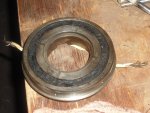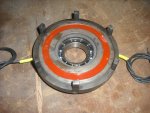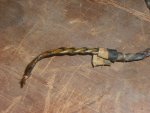alphonso
Well-known member
Italian built lathe, same one as thread below. Uses an electromagnetic brake to stop the spindle. Assembly is buried inside the headstock(at the bottom). After finally figuring out the butchered wiring, I got the brake to function. Worked well for about a week. However, it has started blowing fuses after a short period of time.
I asked the company in Italy what the amp draw should be and they said 1.8 amps. Put the ammeter on it and it is drawing 8 amps and after 10 minutes it blows a 15 amp fuse.
Company says they can get me an assembly for 1100 euros in a week's time.
I wonder, can the electro-magnet be rewound? For less than 1100 euros? What is the exchange rate this week?
I asked the company in Italy what the amp draw should be and they said 1.8 amps. Put the ammeter on it and it is drawing 8 amps and after 10 minutes it blows a 15 amp fuse.
Company says they can get me an assembly for 1100 euros in a week's time.
I wonder, can the electro-magnet be rewound? For less than 1100 euros? What is the exchange rate this week?




